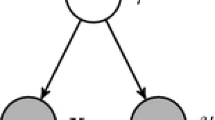Abstract
When applied to supervised classification problems, neural rule extraction aims at making classification mechanisms explicit by reversing the knowledge embedded in a network's connections. To this end, the present research has borrowed notions from information theory; using Conditional Class Entropy as a network cost function improves representation efficiency by forcing the network to emphasize only task-essential information. We present a library of methods to analyse, simplify and rearrange the knowledge embedded in CCE-trained networks; the final result is a hierarchy of if-then rules modelling the classification process in symbolic form. Experimental results on a clinical testbed (diagnosis of Lyme disease) confirmed the effectiveness and the generalisation power of the methodologies described. In addition, satisfactory results obtained on this still unsolved clinical problem endowed this research with interdisciplinary value.
Similar content being viewed by others
References
Towell G, Shavlik J. Interpretation of artificial neural networks: mapping knowledge-based neural networks into rules. Advances in NIPS 4. pp. 977–984, Morgan-Kaufman, 1992
Abe S, Kayama M, Takenaga H, Kitamura T. Extracting algorithms from pattern classification neural networks. Neural Networks 1993; 6(5): 729–735
Oja E. Principal components, minor components, and linear neural networks. Neural Networks November–December 1992; 5(6): 927–936
Fukunaga K. Introduction to Statistical Pattern Recognition, 2nd Ed. Academic Press, 1990
Kramer MA. Nonlinear principal component analysis using autoassociative neural networks. AIChE J February 1991; 37(2): 233–243
Kohonen T. Self-organization and associative memory, 3rd Ed. Springer-Verlag, 1989
Linsker R. Self-organization in a perceptual neural network. Computer 1988; 21: 105–117
Bichsel M, Seitz P. Minimum class entropy: a maximum information approach to layered networks. Neural Networks 1989; 2: 133–141
Burgdorfer W, Barbour AG, Hayes SF, Benach JL, Grunwaldt E, Davis JP. Lyme disease — A tick-borne spirochetosis? Science 1982; 216(1317)
Bernelot Moens HJ, van der Kost J. Computer-assisted diagnosis of rheumatic disorders. Seminars in Arthritis and Rheumatism December 1991; 21(3): 156–169
Moneta C, Parodi GC, Rovetta S, Zunino R. Automated diagnosis and disease characterization by using neural network analysis. In Proc IEEE Int Conf Sys Man and Cybern Chicago, IL, October 1992, pp. 123–128
Barinaga M. Furor at Lyme disease conference. Science 1992; 256(1384)
Fahlman SE, Lebiere C. The cascade-correlation learning architecture. Advances in NIPS 2. pp. 524–532, Morgan-Kaufman, 1990
Kirkpatrick S, Gelatt CD Jr., Vecchi MP. Optimization by simulated annealing. Science 220: 1983; 671
Corana A, Marchesi M, Martini C, Ridella S. Minimizing multimodal functions of continuous variables with the ‘simulated annealing’ algorithm. ACM Trans Math Soft 1987; (51): 262–280
Baba N. A new approach for finding the global minimum of error function of neural networks. Neural Networks 1989; 2: 367–373
Widrow B, Lehr MA. 30 years of adaptive neural networks: perceptron, madaline, and backpropagation. Proc. IEEE September 1990; 78(9): 1415–1442
Weigend R, Rumelhart DE, Huberman BA. Generalization by weight-elimination with application to forecasting. Advances in NIPS 3, Morgan-Kaufman, 1991
Nowlan SJ, Hinton GE. Simplifying neural networks by soft weight sharing. Neural Computation 1992; 4(4): 473–493
Bartee TC, Lebow IL, Reed IS. Theory and Design of Digital Machines. McGraw-Hill, 1962
Michalski R, Carbonell J, Mitchell T. Machine Learning: An Artificial Intelligence Approach, Vol. I. Morgan-Kaufman, 1983
Saito K, Nakano R. Medical diagnostic expert system based on PDP model. In: Proc IEEE Int Conf on Neural Networks 1988; pp. I 255–I 262
Rovetta G, et al. Epidemiology of Lyme borreliosis in Italy. In: Proc V Int Conf on Lyme Borreliosis, A340, Arlington, VA, June 1992
Author information
Authors and Affiliations
Rights and permissions
About this article
Cite this article
Ridella, S., Speroni, G.L., Trebino, P. et al. Class-Entropy minimisation networks for domain analysis and rule extraction. Neural Comput & Applic 2, 40–52 (1994). https://doi.org/10.1007/BF01423097
Received:
Issue Date:
DOI: https://doi.org/10.1007/BF01423097




